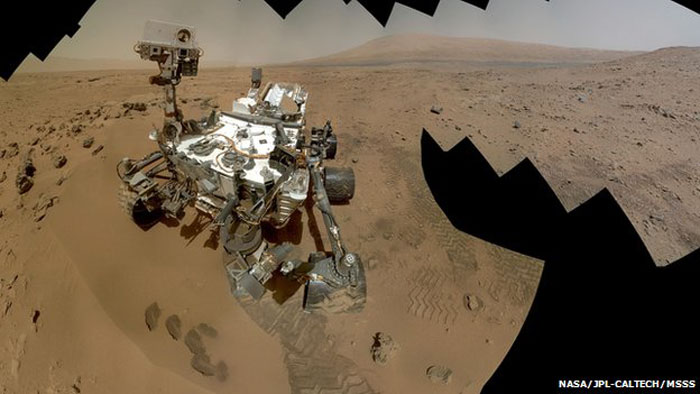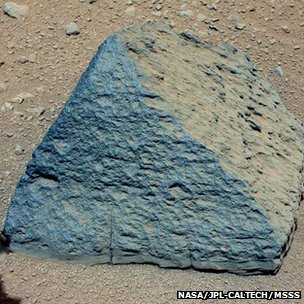.

Curiosity stopped at a location called Rocknest to sample some of the wind-blown sand and dust
.
There is a surprising amount of water bound up in the soil of Mars, according to an analysis done onboard the US space agency's (Nasa) Curiosity rover.
When it heated a small pinch of dirt scooped up from the ground, the most abundant vapour detected was H2O.
Curiosity researcher Laurie Leshin and colleagues tell Science Magazine that Mars' dusty red covering holds about 2% by weight of water.
This could be a useful resource for future astronauts, they say.
"If you think about a cubic foot of this dirt and you just heat it a little bit - a few hundred degrees - you'll actually get off about two pints of water - like two water bottles you'd take to the gym," Dr Leshin explained.
"And this dirt on Mars is interesting because it seems to be about the same everywhere you go. If you are a human explorer, this is really good news because you can quite easily extract water from almost anywhere."
The dean of science at the Rensselaer Polytechnic Institute, New York, has been describing her work with Curiosity in this week's Science In Action programme on the BBC.
The revelation about the amount of water chemically bound into the fine-grained particles of the soil is just one nugget of information to come from a series of five papers in the respected journal describing the early exploits of the rover.
Some of this data has been reported previously at science meetings and in Nasa press conferences, but the formal write-up gives an opportunity for the wider research community to examine the detail.
'Good and bad'
Dr Leshin's and colleagues' publication concerns a sample analysis done at "Rocknest", a pile of wind-blown sand and silt about 400m from where Curiosity touched down on the floor of Gale Crater in August 2012.
The robot used its tools to pick up, sieve and deliver a smidgeon of this Martian dirt to the Sam instrument hidden away inside the belly of the vehicle.
.

The wind has eroded Jake_M into the striking shape of a pyramid
.
Sam has the ability to cook samples and to identify any gases that are released. These products are diagnostic of the different components that make up the soil.
So, for example, Curiosity saw a significant proportion of carbon dioxide - the likely consequence of carbonate minerals being present in the sample. Carbonates form in the presence of water.
And it saw oxygen and chlorine - a signal many had expected to see following similar studies in Mars' "High Arctic" by Nasa's Phoenix lander in 2008.
"[We think these] are break-down products from a mineral called perchlorate, and that's there at about a half-a-percent in the soil," said Dr Leshin.
"If the water was the good news for the astronauts, this is the bad news. Perchlorate actually interferes with thyroid function, so it could be a problem if humans were to ingest some of the fine dust on Mars. It's just something we need to know about now so we can plan for it later."
Scottish link
Three of the other Curiosity papers in the Science Magazine release also concern themselves with the nature of the Martian soil.
The fifth is a report that describes a pyramid-shaped rock found in the vehicle's path. This striking block was dubbed Jake Matijevic, in honour of a recently deceased Nasa engineer.
The team led by Prof Ed Stopler from Caltech, Pasadena, can now confirm that Jake_M is a rock not seen before on the Red Planet.
It is most like a mugearite, says the group - a type of rock found on islands and rift zones on Earth.
"On Earth, we have a pretty good idea how mugearites and rocks like them are formed," said co-worker Prof Martin Fisk from Oregon State University, Corvallis.
"It starts with magma deep within the Earth that crystallises in the presence of 1-2% water.
"The crystals settle out of the magma and what doesn't crystallise is the mugearite magma, which can eventually make its way to the surface as a volcanic eruption."
Mugearite was first identified on Earth by British petrographer/petrologist Alfred Harker. The name references a local croft, Mugeary, on the Isle of Skye, just off the Scottish mainland.
The Curiosity rover is currently engaged in some hard driving in Gale Crater. Since early July, it has been rolling tens of metres a day.
The robot is trying to reach the foothills of the large mountain that dominates the centre of the deep, equatorial impact bowl.
Quelle: BBC
.
Water Discovery Is Good News for Mars Colonists
The discovery of water in the soils of Mars bodes well for potential future settlers, but don't pack your bags quite yet.
Water Found on Mars ... FOR REAL!
The results come from NASA's Mars rover Curiosity, which landed inside a giant impact basin in August 2012 to assess if the planet most like Earth in the solar system has or ever had the chemical ingredients and environments for life.
Its first analysis of fine-grained sand scooped up from the planet’s surface revealed between 1.5 percent and 3 percent of water by weight.
"If you take a cubic foot of that soil you can basically get two pints of water out it -- a couple of water bottles like you'd take to the gym, worth of water," Curiosity scientist Laurie Leshin, of Rensselaer Polytechnic Institute, N.Y., told Discovery News.
"It was kind of a surprise to me," she added.
Leshin and colleagues found the water -- along with sulfur dioxide, carbon dioxide, water and other gases -- by heating tiny bits of the soil inside Curiosity’s onboard laboratory and analyzing released gases with science instruments.
The way the water was released indicates it likely was absorbed into the soil from the atmosphere, a telltale clue that water-laced soil is globally spread.
NEWS: This Scoop of Mars Soil is Two Percent Water
"The water is not very well bound at all. You still have to sort of gently heat this stuff, but it comes off pretty easily," Leshin said.
"It’s good news from the point of view of future of human space missions," added Curiosity lead scientist John Grotzinger, with the California Institute of Technology.
"It’s also good news from the point of the view of microbes. If there’s a chance for modern life on Mars, if there was a way that these fine materials could have been exploited to produce water, it might have helped in that sense," Grotzinger told Discovery News.
The analysis, however, also revealed a potential hazard in the soil -- perchlorates, which are known to impact human thyroid production of hormones.
"We would need to think about how we would mitigate any hazard from that," Leshin said.
As a first step in developing technology to live off the Martian land, NASA is planning to include an experiment on its next rover that would pull carbon dioxide out of the atmosphere and purify it. Ultimately, the gas could be converted into oxygen for breathing and for propellant. The rover, which will be a copy of the Curiosity chassis and landing system, but with different science instruments, is targeted for launch in 2020.
Curiosity’s analysis also showed no clear indigenous source for organic carbon found on Mars, though it did not rule out that possibility either.
The research appears in special report in this week’s Science on the first 100 days of the Mars Curiosity mission.
Quelle: D-News
4858 Views

